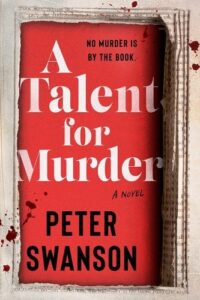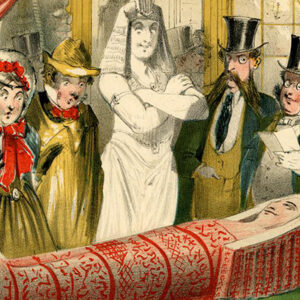To read a Peter Swanson book is to become immersed in a slightly askew world – people are still people, yes, but many of these individuals inhabit their own tangled realms, not the least of which is the scheming, cheating, lying one where said people frequently make bad decisions. But there’s more: killers. Always killers. They’re all here in Swanson’s delicious new novel, A Talent for Murder.
Spoiler alert: this article contains what some might construe as a spoiler.
After a prologue that ends in a sudden death, we meet Martha Ratliff, a spinsterish librarian who has married a man named Alan Peralta after a quick courtship. Alan is a traveling salesman who goes to educational conferences flogging “novelty clothing items” such as t-shirts with slogans on them: MATH TEACHERS AREN’T MEAN. THEY’RE ABOVE AVERAGE.
But at times, Alan acts strangely, and Martha comes to realize she really doesn’t know him all that well. When he returns from a conference, she watches him from a window as he gets out of his car. “…it was like she’d never seen him before. His face had an almost cold, ruthless look to it. She told herself that she was seeing him from a distance, and that he was tired, but still, it was alarming to witness an expression on his face that she felt she’d never seen before. After gathering his luggage and locking his car, he then stood for a moment looking toward the sunset, his jaw slack, his eyes empty and uncaring. Then she watched him take a deep breath, swelling his chest. He shook his head and his expression changed, back to the vacuous sweetness of the Alan she knew. He even smiled, as though he were willfully transforming himself. Then he headed indoors.”
Martha wants to believe that perhaps Alan is just an odd fellow, but the incident eats away at her. Soon, sorting laundry, she notices what looks like a spot of blood on one of his shirts. Instead of broaching the issue with Alan, she goes online and finds with a little research that a woman was believed to have committed suicide at the same location where Alan had been at the conference.
Finally, at dinner, she asks him point blank about the spot on the shirt. His squirming response isn’t exactly reassuring. “You think I’m some kind of serial killer, Martha?” he responds. “It was an obvious joke, but something in his tone made Martha’s flesh crawl a little bit.” Her curiosity increasingly piqued, she soon discovers several more instances of women, many of them sex workers, dying in various ways, correlating with Alan’s presence at more than a few conferences.
She decides she needs a confidant and reaches out to a college friend, Lily Kintner, for support. With the introduction of Lily, (oh-so wily) Swanson begins mostly alternating chapters with Martha remaining in the third person and Lily narrating her part of the story.
Swanson is on record saying he enjoys creating new characters, and he would have to fall in love with a character to “bring them back in another book.” Well, it’s now clear he’s more than just a little smitten with Lily. She appeared in two previous novels, The Kind Worth Killing (2015) and a sequel, The Kind Worth Saving (2023).
Says Swanson: “Lily Kintner wasn’t even supposed to be the main character in The Kind Worth Killing, but as I was writing she began to take over the story. I suppose that has something to do with me falling in love with her as a character. She was compelling to write, and it also didn’t hurt that so many readers have told me that she is one of their favorite characters in all of my books.”
And why is Lily always in the first person, while, with one exception, (Henry Kimball, a detective who knows Lily) all the other protagonists remain in third person?
Asked about the challenges and pleasure that might be for the author in using both tenses in the same story, Swanson acknowledges, “It’s funny because if I was writing The Kind Worth Killing now I would probably put all the characters in the third person, but when I began that book the story was going to be a cat and mouse between two characters (wound up being closer to five) so I thought we needed to hear their voices. But at this point I am very used to writing Lily in the first person. Henry is a little different, partly because in A Talent for Murder he’s been sidelined a little bit, so it made sense that he was no longer in the first person.”
In grad school, Lily had helped Martha extricate herself from a sick love affair with the charismatic but depraved Ethan Saltz, a visiting writer in creative nonfiction. Ethan cruelly seduced Martha into a variety of often deviant sexual experiences, and he’s a manipulator of the highest order. In a sly, clever aside, Lily shadows Ethan and Martha in a college bar, carrying a copy of Angela Carter’s classic short story collection, The Bloody Chamber, which takes traditional fairy tales, as the inspiration point for often gory, shocking retellings – with the kind of behavior in them Lily clearly relishes. Role models, of a sort.
The history between Lily and Martha is strong, and suffice to say, the two team up. Is Alan a serial killer?
In typical Swansonian fashion, the spectacular twists begin, and Part 1 of the story ends on a piercing note.
So, does Swanson plot out these intricate stories entirely in advance? Not exactly.
“Well, I have the beginning of the story and I often have the end. It’s the middle that I usually have to figure out. And that part I basically make up as I go along, trying to let the characters push the narrative. I do think it’s important when writing crime to know who the villain is and what they are up to (often they drive the story), but I’ll admit that the bad guys (and girls) occasionally change midway through the book.”
There are many thriller writers out there who just throw out twist after twist in the story and for this reader, destroy any credibility they have in terms of caring about the actual reading experience. Swanson keeps us on our toes, and never less than adroitly.
And in that vein, what inspires him plot-wise? Do, say, news items give a kernel of a story?
“Firstly, my plots definitely don’t come from newspapers or true crime, neither of which interest me at all (at least in relation to my job as a mystery writer). But what I try to do is make sure that the plot I’m working on is complex enough to support a full-length novel.
“Often I think that there needs to be two central ideas at work as opposed to just one. And then, instead of thinking about twists, I think about reveals, about when to let certain elements be known to the reader. It’s a tricky process so I just sort of feel my way through it. But there is one mantra that I always say to myself, which is, if you want to surprise the readers then find a way to surprise your characters. That seems to help.”
In Part 2, while Alan isn’t marginalized, the spotlight focuses on the diabolical Ethan Saltz. He’s quite the successful serial killer, it seems – since college he’s up to 26 victims…and counting. He leads a double life, as Robert Charnock, “an art dealer with a residence in Philadelphia. The real Robert Charnock had been a germophobic recluse who was currently at the bottom of a kettle pond in Wellfleet, Massachusetts.” He’s married to Rebecca Grubb, a woman who is compliant and unconcerned about what he does when he leaves for “art buying trips.”
“The best part of having a wife,” he muses, “was that men without wives were always a little suspicious. Wives were gatekeepers, really, telling the world that the man they had married had been thoroughly vetted and passed some sort of test. This only worked if the wife in question had character. And Rebecca had character. In her case, that meant she had money and clout…She was his disguise.”
The story becomes a high stakes dance between Lily and Ethan, with a lengthy cameo from detective Henry Kimball, an associate, so to speak, of Lily’s from the past. Ethan’s desire for revenge for Lily helping Martha break away from him in college sneaks up to him during a session on Facebook – Martha shows up in his (fake-named) feed. He becomes mesmerized by the beacon of his hideous desire.
Swanson’s novels are filled with little expository details, many of them laugh-out-loud funny. Lily and Martha initially reconnect at a faux Irish pub called Tipsy McStaggers. As the suspense rachets up, Ethan is stalking Lily. He needs a place to “browse” while he waits for her to appear: “There was a bookstore called Stone’s Throw, but people noticed browsers in bookstores. It was probably filled with lonely [local] women hoping to find some man flipping through the latest Margaret Atwood book so they could strike up a conversation. The best stores to browse in if you didn’t want to be noticed were drugstores.
“Everyone shopping in drugstores was in their own little bubble of solipsistic anxiety, just hoping to get out of there as soon as possible. No one wants to run into a neighbor while holding a tube of hemorrhoid cream.”
Rather self-effacingly, Swanson says, “To be honest, any time I’ve tried to be funny in a book it falls flat.” (He’s clearly the only one who feels that way!) “But I love humor in crime novels—sly humor in the Patricia Highsmith vein—and I’m glad to hear that you find it in my books. I think it lands there naturally because on my sensibility. My biggest non-writer influence is Alfred Hitchcock and no one knew how to inject humor into crime stories more than he did.”
Wanting to know more about his writing process, I said I can imagine you in the supermarket waiting in line to pay and overhearing someone say something that “speaks” to you. Does this ever happen?
“I do listen in on people’s conversations,” replies Swanson. “It’s the reason that I can’t write in coffeeshops. And, yes, certain things speak to me, and that somehow gets translated into my personal style of writing. But, honestly, I couldn’t define it. My early stuff—my early writing—sounded like whoever I was reading at the time. Raymond Chandler, John D. MacDonald, Ruth Rendell, etc. But somewhere along the way something emerged that was my own voice. I think it’s just a matter of taking the time and being willing to write garbage. But now I feel like I have my own voice, for better or for worse.”
And literary influences? The Kind Worth Killing feels like a homage to the talented Ms. Highsmith, with Swanson’s own distinctive flavor…speaking of the homage, I can’t imagine a better one to crime fiction in general than Eight Perfect Murders!
“Sometimes I think the central theme of all my books is the inspiration I have found from other writers especially in the field of classic crime and mystery. Whenever I begin writing a new book, I privately come up with the novels I’m hoping to pay homage to.
“For The Kind Worth Killing I was thinking very much about Patricia Highsmith, and how she created characters that existed in this grey murk of morality.
“For Every Vow You Break I was channeling my inner Ira Levin. And for Eight Perfect Murders I was thinking about a lot of authors, really just delving into what it’s like to be an obsessive reader of crime. For that reason it’s my personal favorite book I’ve written because my research for that novel was essentially re-reading all my favorite books.”
What about TV/Movie rights, or anything in production? If we were in Britain, you’d have a series for most of the stories, right?
“Nothing in production right now, but some things are in pre-production. I’ve learned, in my short stint as a published writer, to not get too excited about the possibility of a TV series or a film getting made. It rarely happens. That said, and because you asked me about British TV, there is a chance right now that my novella, A Christmas Guest, might wind up on UK television at some point.”
After ten very satisfying, very well received novels – including the novella, are you running out of steam? What are you working on now?
“I’m about to finish a first draft of what I hope will be an interesting story. I won’t say too much about it except that it tells a murder story (and a marriage story) but tells it backwards.”
Yet another innovative concept. Who would doubt it will be “interesting?” Much of the pleasure of reading Swanson is seeing his characters reflected in a cracked fun-house mirror. Swanson’s carnival may leave you a little dizzy, but you’ll be back – ticket in hand – as soon as it returns to town.


















